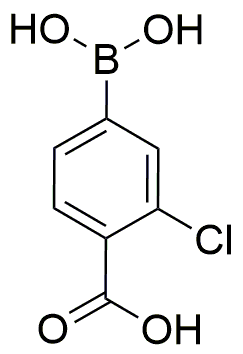4-Carboxy-3-chlorophenylboronic acid is widely utilized in research focused on:
- Pharmaceutical Development: This compound serves as a key intermediate in the synthesis of various pharmaceuticals, particularly those targeting cancer and diabetes, due to its ability to form stable complexes with biomolecules.
- Bioconjugation: It is employed in bioconjugation processes, allowing researchers to attach drugs or imaging agents to proteins, enhancing their therapeutic efficacy and diagnostic capabilities.
- Material Science: The compound is used in the development of advanced materials, such as sensors and polymers, where its boronic acid functionality can form dynamic covalent bonds, leading to innovative applications in electronics.
- Organic Synthesis: It plays a significant role in organic synthesis as a reagent for Suzuki-Miyaura coupling reactions, which are vital for constructing complex organic molecules in a more efficient manner.
- Environmental Monitoring: This chemical is also applied in environmental science for detecting and quantifying phenolic compounds in water samples, contributing to pollution control and environmental safety.
General Information
Properties
Safety and Regulations
Applications
4-Carboxy-3-chlorophenylboronic acid is widely utilized in research focused on:
- Pharmaceutical Development: This compound serves as a key intermediate in the synthesis of various pharmaceuticals, particularly those targeting cancer and diabetes, due to its ability to form stable complexes with biomolecules.
- Bioconjugation: It is employed in bioconjugation processes, allowing researchers to attach drugs or imaging agents to proteins, enhancing their therapeutic efficacy and diagnostic capabilities.
- Material Science: The compound is used in the development of advanced materials, such as sensors and polymers, where its boronic acid functionality can form dynamic covalent bonds, leading to innovative applications in electronics.
- Organic Synthesis: It plays a significant role in organic synthesis as a reagent for Suzuki-Miyaura coupling reactions, which are vital for constructing complex organic molecules in a more efficient manner.
- Environmental Monitoring: This chemical is also applied in environmental science for detecting and quantifying phenolic compounds in water samples, contributing to pollution control and environmental safety.
Documents
Safety Data Sheets (SDS)
The SDS provides comprehensive safety information on handling, storage, and disposal of the product.
Product Specification (PS)
The PS provides a comprehensive breakdown of the product’s properties, including chemical composition, physical state, purity, and storage requirements. It also details acceptable quality ranges and the product's intended applications.
Certificates of Analysis (COA)
Search for Certificates of Analysis (COA) by entering the products Lot Number. Lot and Batch Numbers can be found on a product’s label following the words ‘Lot’ or ‘Batch’.
*Catalog Number
*Lot Number
Certificates Of Origin (COO)
This COO confirms the country where the product was manufactured, and also details the materials and components used in it and whether it is derived from natural, synthetic, or other specific sources. This certificate may be required for customs, trade, and regulatory compliance.
*Catalog Number
*Lot Number
Safety Data Sheets (SDS)
The SDS provides comprehensive safety information on handling, storage, and disposal of the product.
DownloadProduct Specification (PS)
The PS provides a comprehensive breakdown of the product’s properties, including chemical composition, physical state, purity, and storage requirements. It also details acceptable quality ranges and the product's intended applications.
DownloadCertificates of Analysis (COA)
Search for Certificates of Analysis (COA) by entering the products Lot Number. Lot and Batch Numbers can be found on a product’s label following the words ‘Lot’ or ‘Batch’.
*Catalog Number
*Lot Number
Certificates Of Origin (COO)
This COO confirms the country where the product was manufactured, and also details the materials and components used in it and whether it is derived from natural, synthetic, or other specific sources. This certificate may be required for customs, trade, and regulatory compliance.


